This post may contain affiliate links. Please read our disclosure policy.
How to pasteurize eggs at home using one of three simple methods: stovetop, sous vide, or microwave (for egg yolks). Once pasteurized (heat-treated to reduce pathogens), you’ll be whipping up tons of treats, confident in the fact you can avoid any food-borne illnesses!
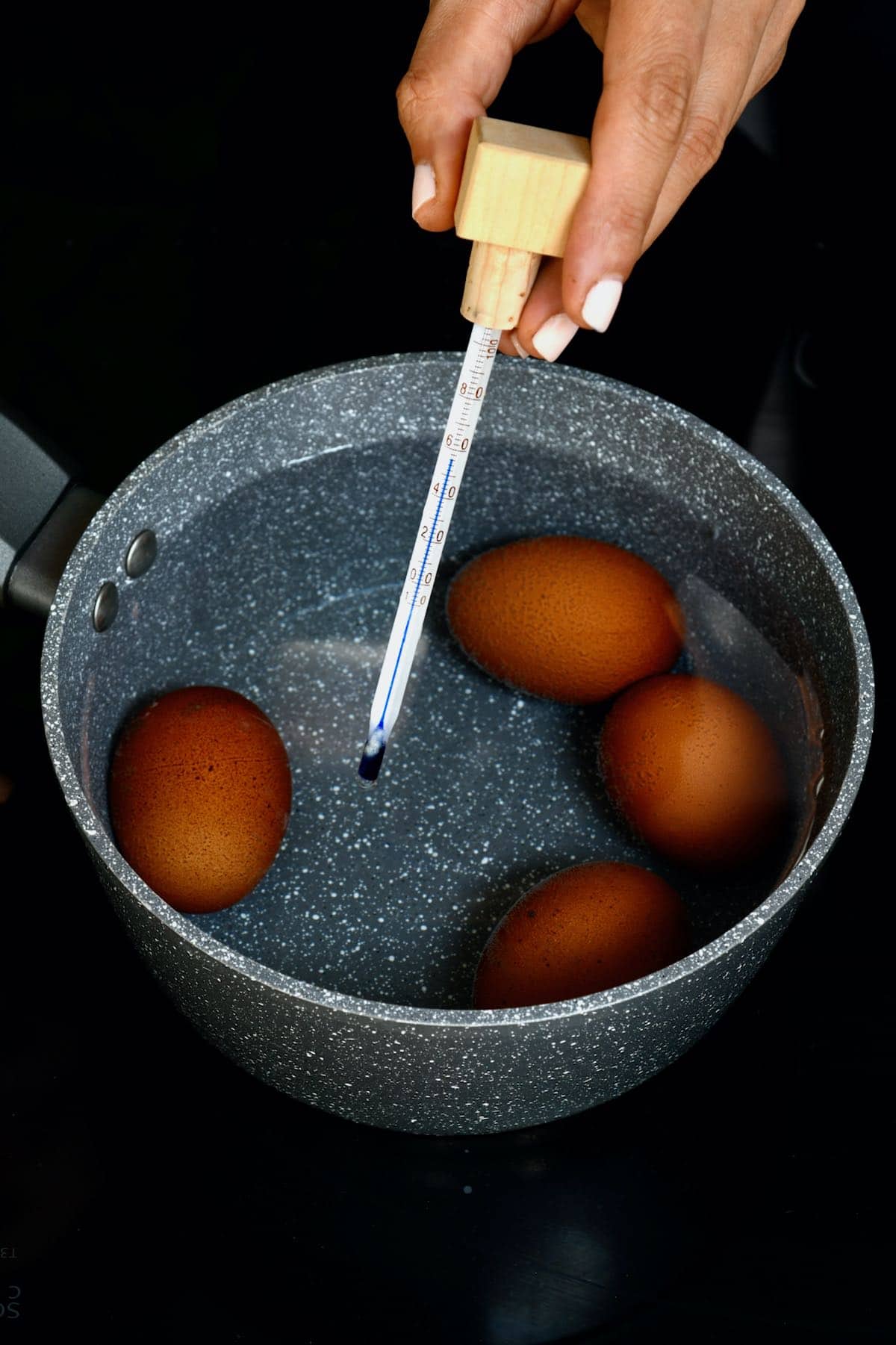
If you’re someone who, like me, loves to whip up all kinds of desserts and treats at a moment’s notice, then you’ve probably noticed several recipes that call for raw eggs, like homemade mayonnaise, royal icing, or authentic tiramisu – for example. Unfortunately, with the risk of food-borne illnesses like salmonella, it’s understandable that not everyone feels comfortable attempting these recipes and consuming raw eggs.
To be honest, it might be a bit of a Western thing – I know countries all over the world consume raw eggs with no difficulty – like in Korean bibimbap bowls, Japanese mixed egg rice (tamago kake gohan), and let’s not forget the athletes who drink straight-up raw eggs… However, if you’ve ever had salmonella, then you know it’s no joke! So, better safe than sorry in my eyes!
Did you know that salmonella is usually actually on the outer shell of eggs and only spreads inside once the eggs are cracked open?
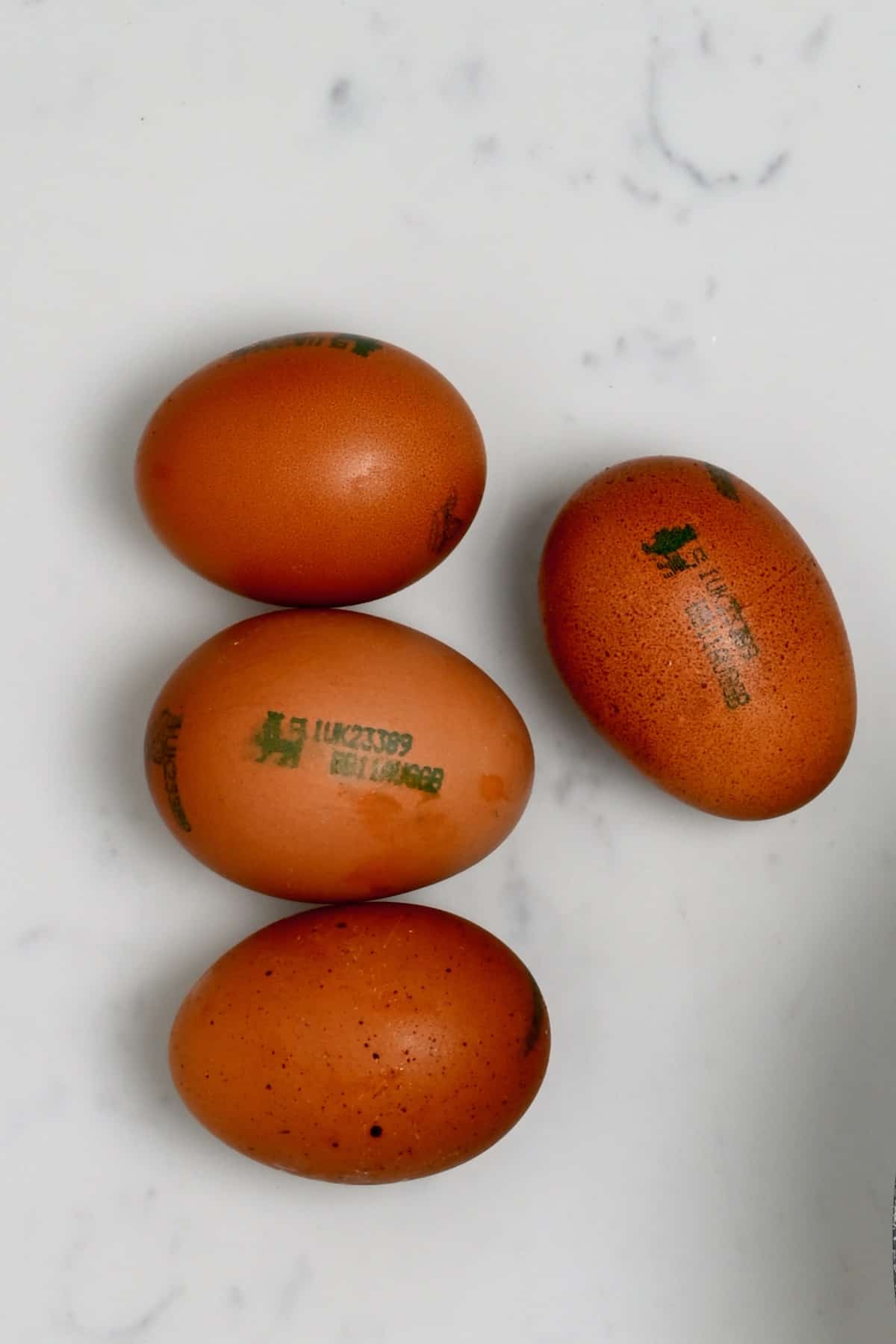
Unfortunately, buying pasteurized eggs in the supermarket is often more costly. For that reason, learning how to pasteurize eggs at home is not only convenient (just pasteurize the exact amount you need) but also cost-efficient!
Want to save this recipe?
What are Pasteurized Eggs?
The process of pasteurization is when a food item is heated and cooled to specific temperatures to reduce/eliminate certain germs and pathogens and extend shelf life.
For pasteurized eggs, the point is to reduce the risk of any food-borne illness (such as salmonella) from dishes when eggs are used, either raw or only lightly cooked. For example, mayonnaise, meringue, crème patissiere, eggnog, and tiramisu!
What You’ll Need
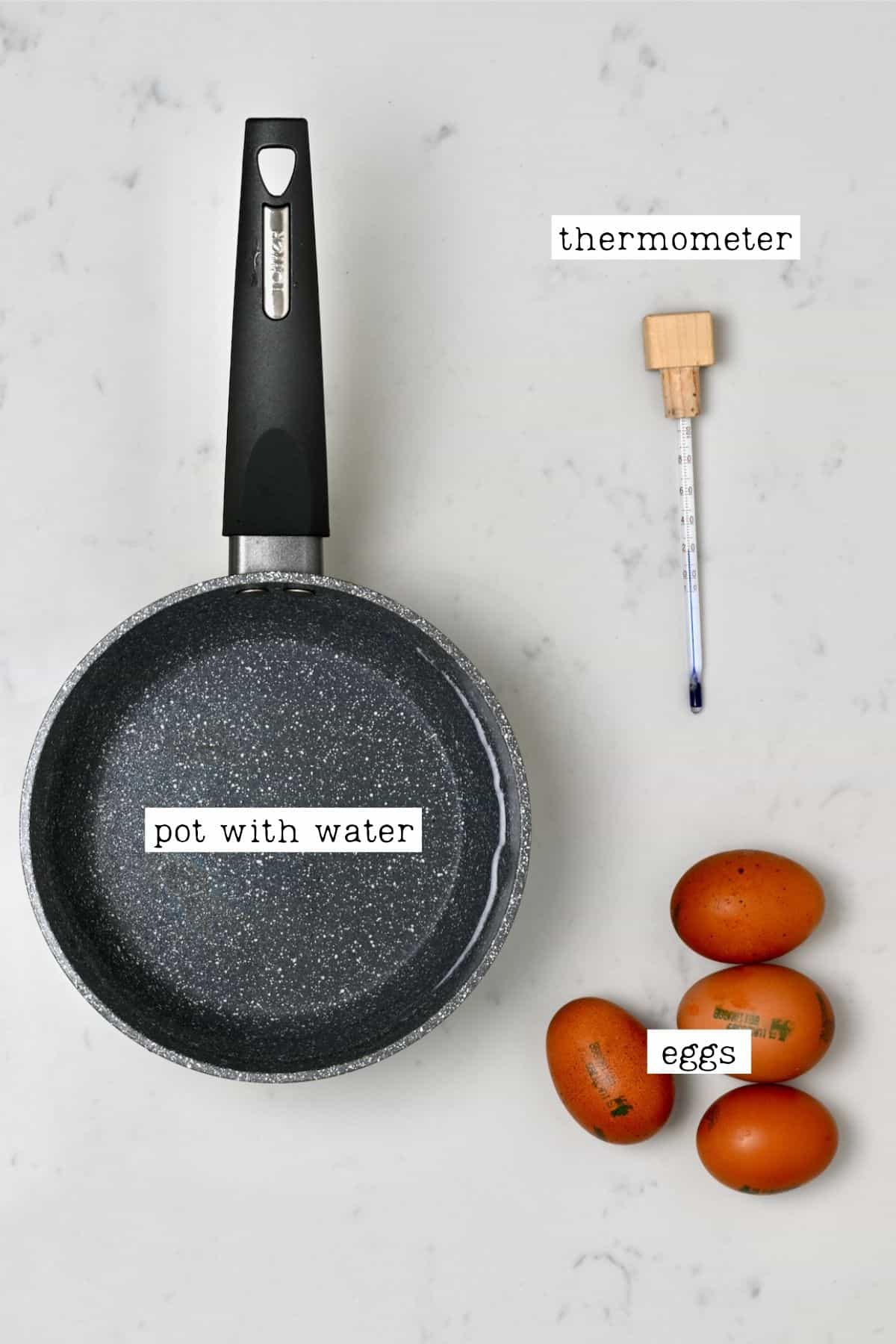
- Eggs: use the eggs of your choice – at room temperature (not chilled, straight from the fridge).
- Ice bath: you can use either a bowl filled with cold water and ice or just ice water. This is important for cooling down the eggs so that you don’t ACTUALLY cook them accidentally.
Other Tools
Method 1
- Kitchen Thermometer: it is important to use a thermometer to ensure the eggs reach the correct temperature without accidentally cooking.
- Pot with water: you’ll need a saucepan large enough to fit all the eggs you need to pasteurize, plus an extra inch of water.
Method 2
- Sous Vide kit and and pot with water: you’ll need a sous vide kit for low temperature long time cooking.
Method 3
- Microwave
- Whisks: you’ll need 3 separate clean whisks or forks (you won’t have time to clean them in-between uses, that’s why 3 separate whisks/forks are required).
- An acid and water: lemon juice or white wine vinegar – this will raise the temperature that the yolks will cook, allowing you to pasteurize the yolks in the microwave without cooking them. Per 4 eggs, you will need 2 Tbsp acid and 4 Tbsp water.
How To Pasteurize Eggs?
Method 1: On the Stovetop
First, transfer the room-temperature eggs to a saucepan with cold water (about 1 inch above the eggs), and heat up over medium heat until the temperature reaches 140ºF/60ºC.
Maintain that temperature for at least 3 minutes (3.5 minutes to be extra safe) either by lowering the heat slightly or adding a little cold water. You don’t want the temperature to go above 142ºF/61ºC; otherwise, the egg will begin to cook.
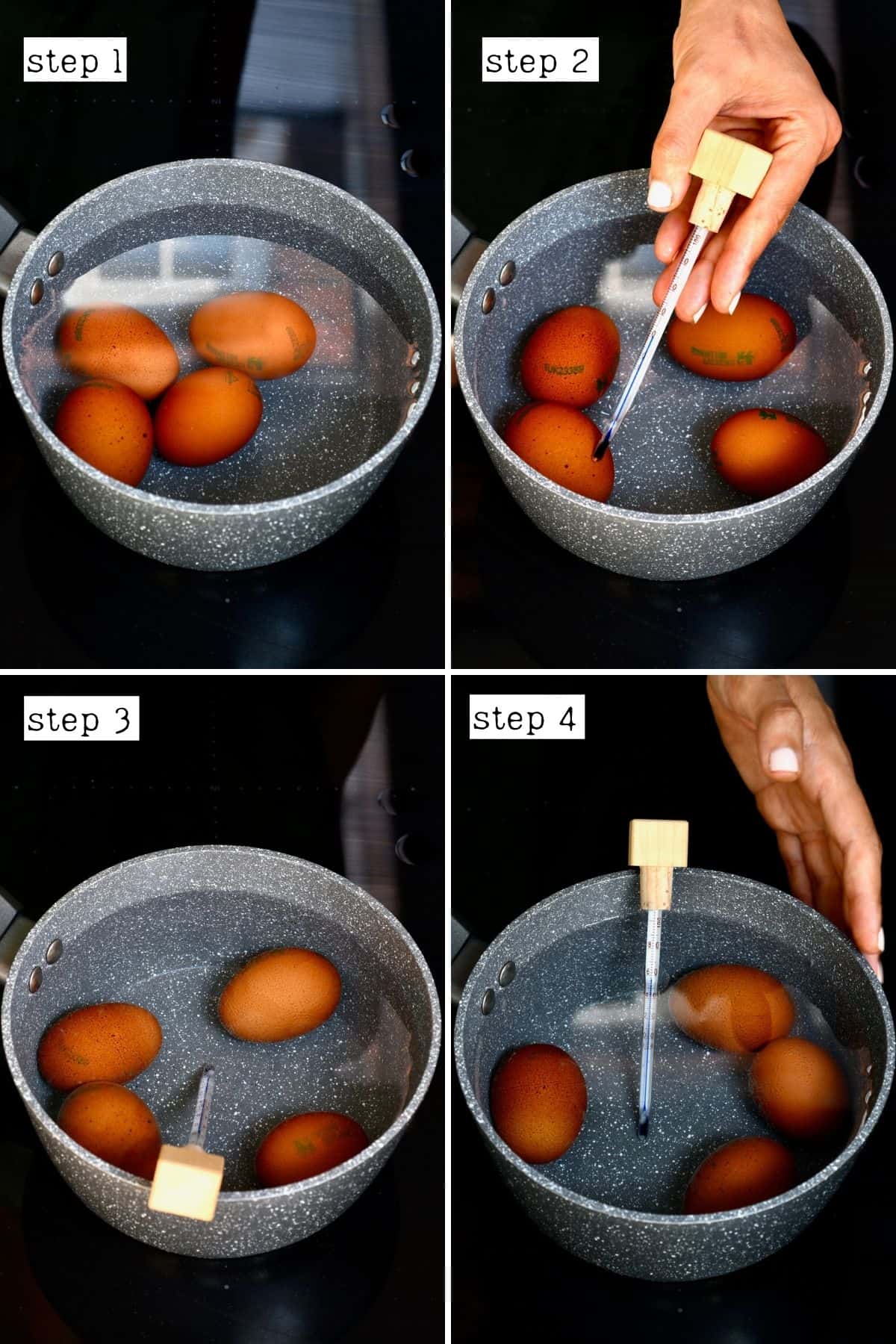
After three minutes, quickly transfer the eggs to the ice water/ice bath to stop them from cooking further.
Once cooled, use them as required in your recipe or refrigerate them.
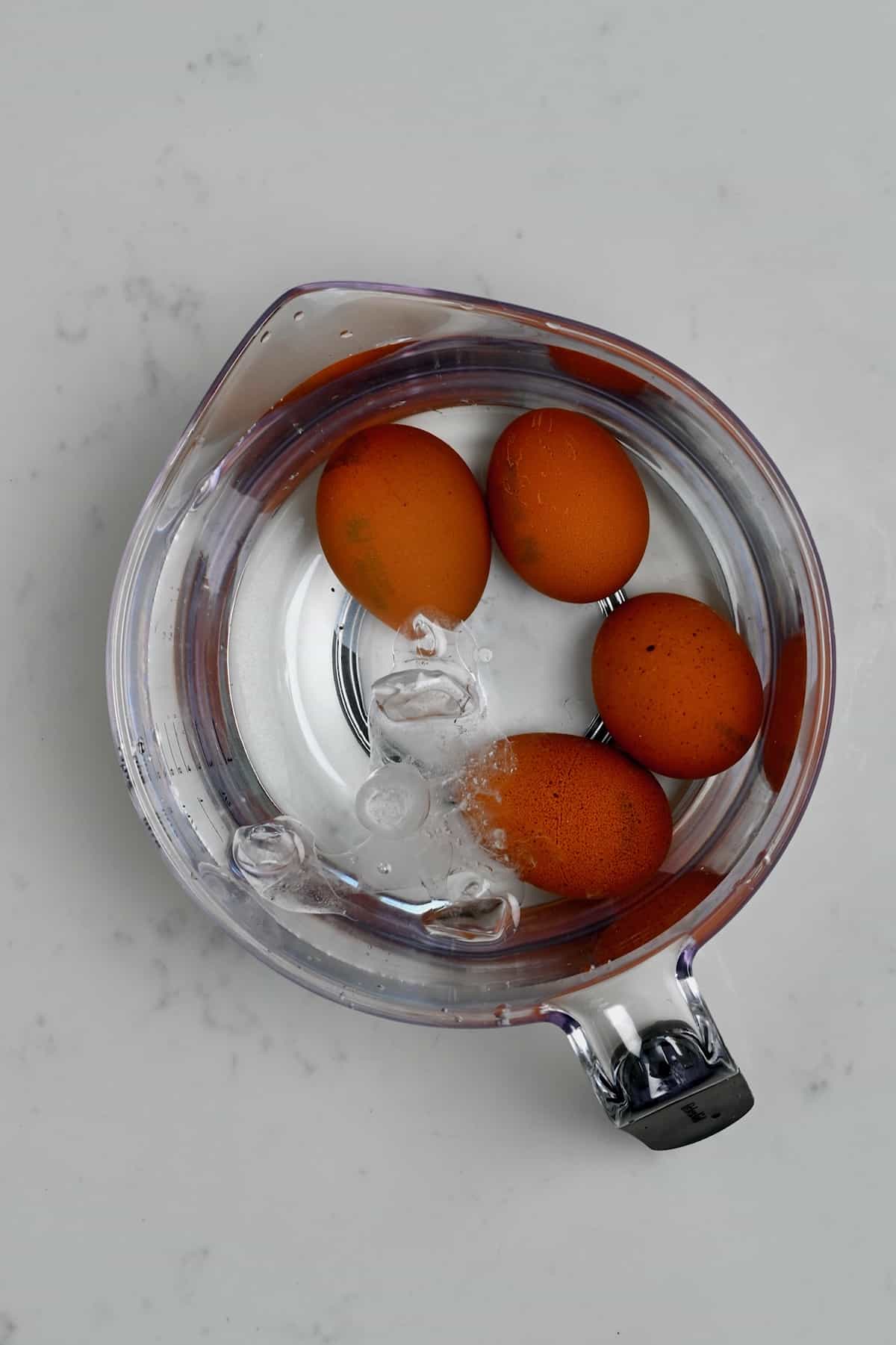
Alternative method: Stovetop (out of shell)
For an even “safer” egg pasteurization, you can do the process out of the shell. To do so, use a double boiler method (placing a heat-proof bowl over a pan of simmering water – making sure the water isn’t touching the bottom of the bowl).
Using this method, you can pasteurize whole eggs, whites, or yolks – usually with a small portion of the liquid from whatever recipe you’re creating (1/4 cup per egg, and 2 Tbsp per yolk or white). Bring the mixture’s temperature to 160ºF/71ºC (it’s a higher temperature since it isn’t eggs alone), constantly stirring, so the eggs don’t start to cook/coagulate on the bottom/sides of the bowl.
When ready, either continue with the recipe immediately or place the bowl in an ice bath to cool down the eggs first.
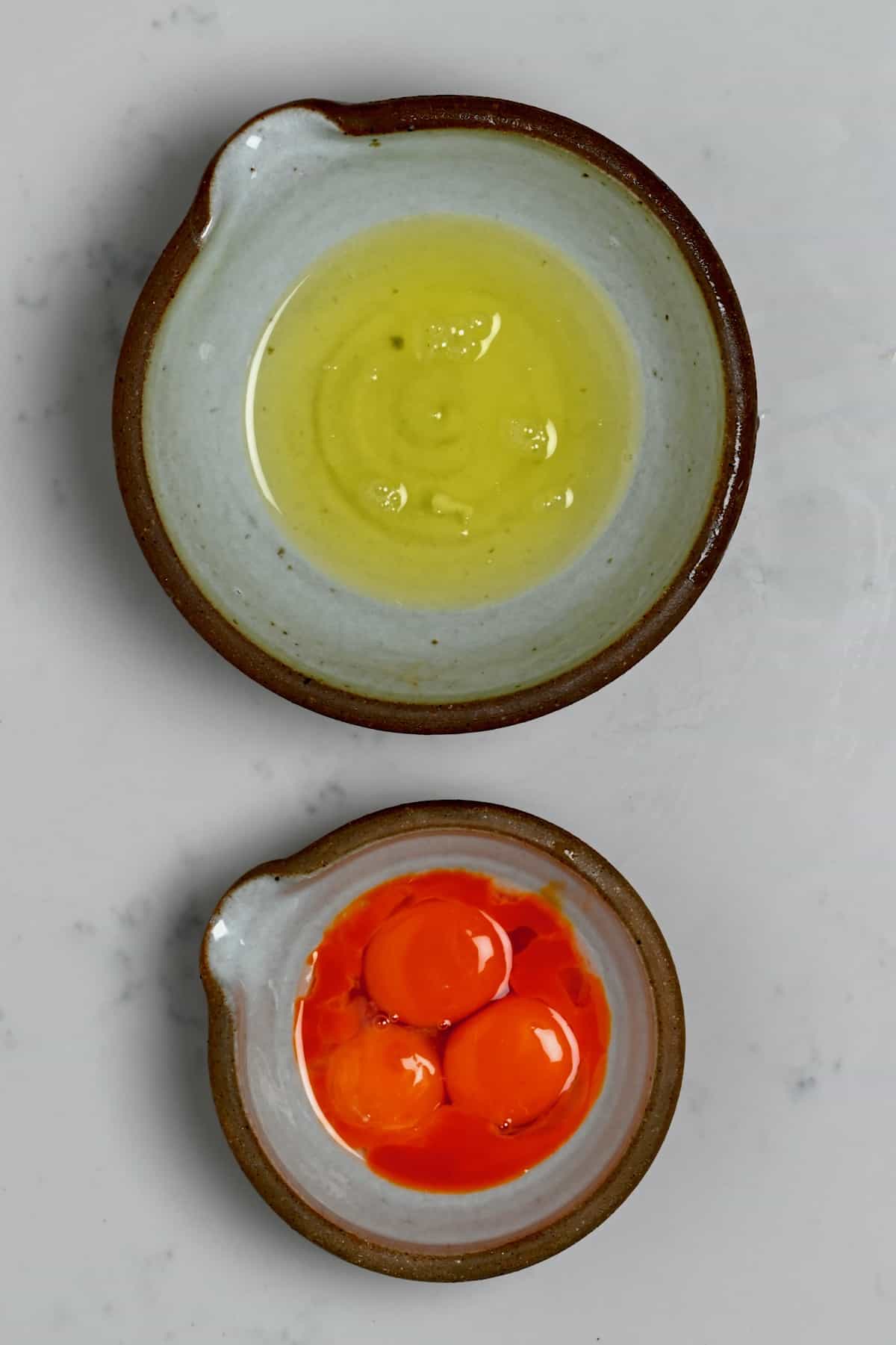
Method 2: Using Sous Vide
Set the sous vide temperature to 135ºF/57ºC and allow the water to warm up. Then place the eggs in the pot (using a slotted spoon or inside a plastic bag) and allow them to pasteurize for 75 minutes.
You can also pasteurize the egg whites separately by placing them in a bag in the water.
Then, transfer the eggs to an ice bath for around 20 minutes to cool.
Method 3: Pasteurize egg yolks in microwave
First, separate the eggs into yolks and whites and place the yolks in a microwave-safe dish, whisking well.
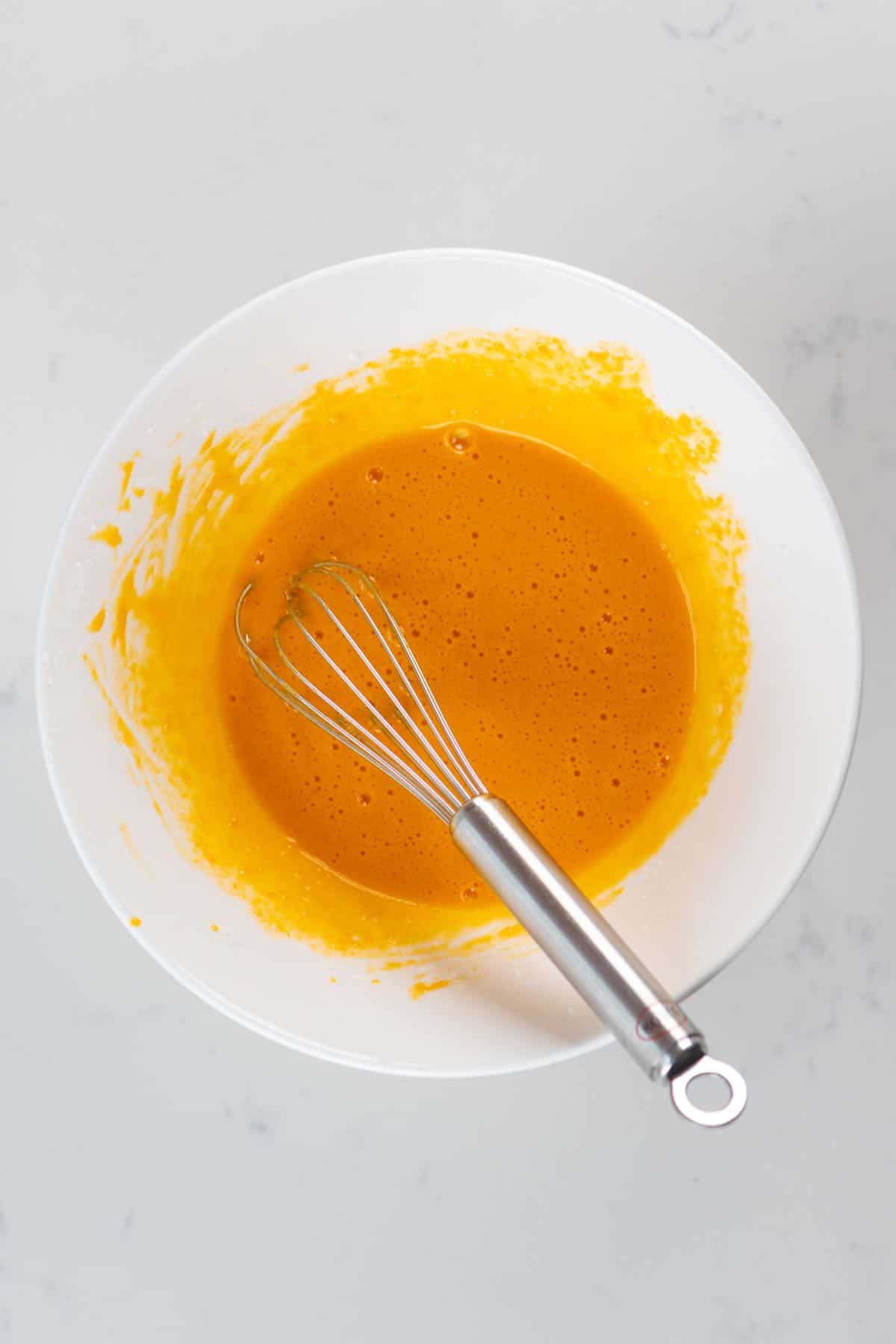
Add the lemon juice/vinegar and whisk again, then add the water and whisk once more. Then cover the bowl with plastic wrap (or a small plate).
Heat the egg yolks in the microwave until the surface of the eggs begins to rise. The exact time will depend on your specific microwave. However, 45-60 seconds is average. Once the surface begins to rise, heat for extra 8 seconds.
Then, quickly remove it from the microwave and whisk it with a new clean whisk. Place it back in the microwave and heat on high again until the surface rises, plus an extra 8 seconds.
Finally, remove it from the microwave once more and whisk one final time (with a new whisk) until smooth and creamy.
How to Store?
Any eggs pasteurized in the shell with last between 2-3 weeks in the fridge, though I aim to use them within a week. If storing pasteurized eggs together with non-pasteurized, I recommend marking the pasteurized ones with a “P” (or another marking).
Alternatively, any eggs pasteurized outside of the shell should be used immediately!
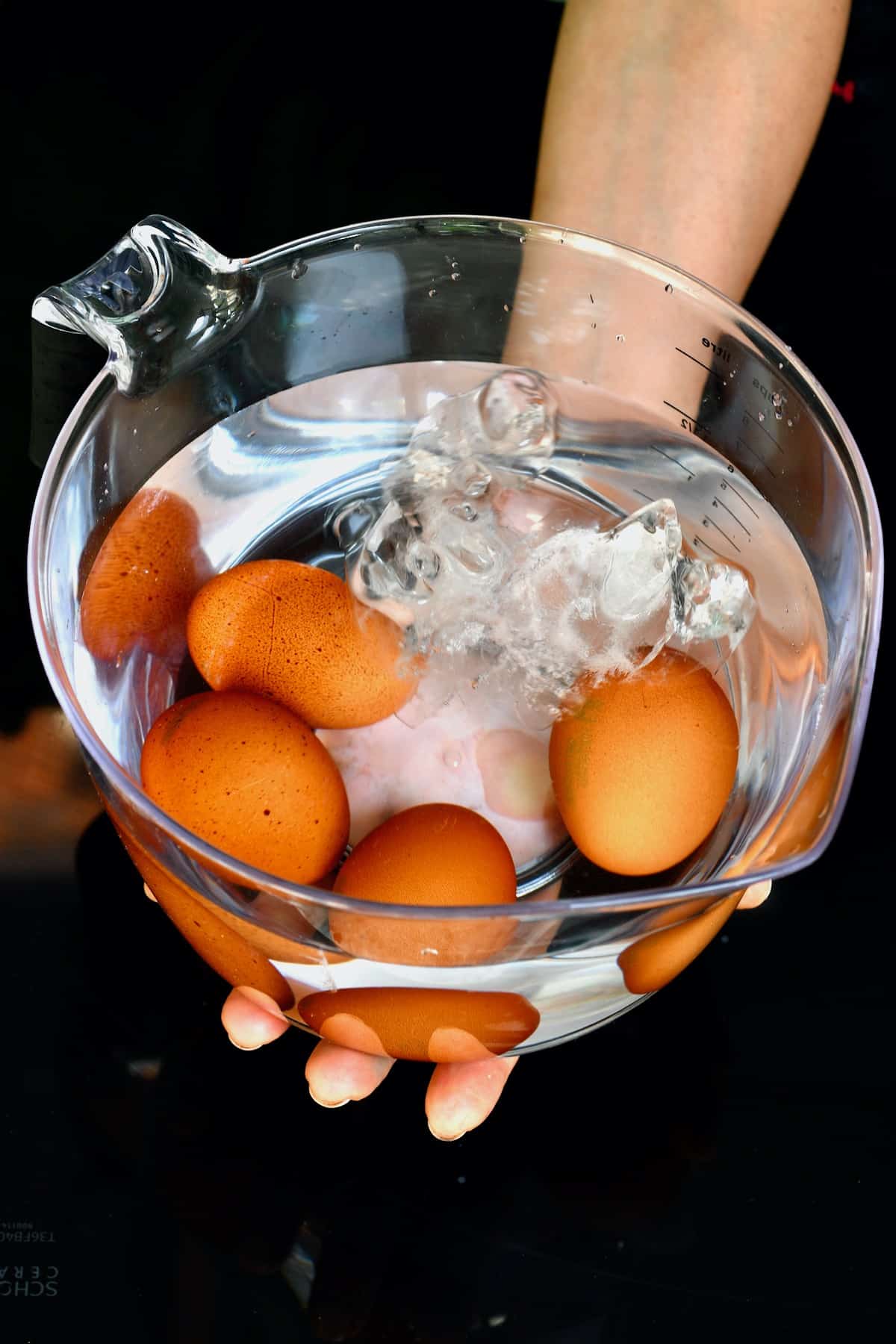
FAQs
There’s no way to tell just from looking at an egg whether it’s pasteurized or not. However, if the eggs are pasteurized, it should say so somewhere on the carton/egg box.
Definitely not – in fact, most are not. They are more likely to be pasteurized when sold as an egg product rather than whole eggs (i.e., carton of egg whites, etc.). Pasteurized eggs in the shell are also usually kept in the fridge section, as far as I’m aware.
The important thing when pasteurizing eggs is to make sure that the egg yolk reaches an internal temperature of 138ºF/58.9ºC. This is obviously harder to tell when pasteurizing them in the shells – but that’s why these methods have been carefully tested.
Because the sous vide method uses a lower temperature, the eggs need longer to reach the correct internal temperature and kill any harmful bacteria. However, the longer pasteurization time makes for the highest reduced risk of harmful pathogens.
Yes, they certainly will – they should work in the same way as other raw eggs.
The safest methods of pasteurization do so with the egg outside of the shell. That way, you can accurately measure the egg’s temperature to know that it has reached 140ºF/60ºC.
Recipe Notes and Top Tips
- Using different egg sizes: all these methods have been tested for medium/large eggs. If you want to pasteurize any extra-large eggs, I recommend increasing the cooking time in Method One to 5 minutes (instead of three).
- Method 1 accuracy: I feel like it’s important to mention that I can’t guarantee that this method will completely eliminate the risk of food-borne illness, but it should highly reduce it at least. The most accurate method would be using the sous vide, with longer “heating” times to kill germs more accurately, etc.
- Use fresh eggs: they should be clean, contain no cracks, and be fresh.
- If your eggs aren’t at room temperature: take them out of the fridge to get to room temperature at least 20 minutes before starting the process, or until the shell feels close to room temperature.
- The best thermometer: any kitchen thermometer will work for these methods. However, digital thermometers may be best at reading temperature fluctuations in a more precise way.
More Eggy Dishes
- How to boil eggs perfectly (soft, medium, hard)
- Air Fryer Boiled Eggs (Soft, Medium, + Hard Boiled)
- French baked eggs
- Italian eggs in purgatory
- Sweet potato breakfast hash
- Savory oatmeal with egg
- Mexican huevos rancheros
- Easy Turkish Menemen (Scrambled Eggs with Tomatoes)
- Fluffy Scrambled Eggs (With Butter | + Flavor Variations!)
- How Do You Poach an Egg? (+ Top Tips | Multiple Methods)
If you try any of these methods for how to pasteurize eggs, I’d love to hear your thoughts/questions below. Also, I’d appreciate a recipe card rating below, and feel free to tag me in your recipe recreations on Instagram @Alphafoodie!
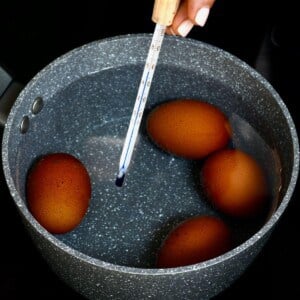
How to Pasteurize Eggs (4 Methods)
Equipment
Ingredients
- 4 eggs or as many as your recipe calls for
Instructions
Method 1: On the Stovetop
- For this method, you will also need a kitchen thermometer, a pot with water (to warm up the eggs in), and a bowl with ice water.
- Transfer the room-temperature eggs to a saucepan with cold water (about 1 inch above the eggs), and heat up over medium heat until the temperature reaches 140ºF/60ºC.
- Maintain that temperature for at least 3 minutes (3.5minutes to be extra safe) either by lowering the heat slightly or adding a little cold water. You don't want the temperature to go above 142ºF/61ºC; otherwise, the egg will begin to cook.
- After three minutes, quickly transfer the eggs to the ice water/ice bath to stop them from cooking further.Once cooled, use them as required in your recipe or refrigerate them.
Alternative method: Stovetop (out of shell)
- For an even "safer" egg pasteurization, you can do the process out of the shell. To do so, use a double boiler method (placing a heat-proof bowl over a pan of simmering water – making sure the water isn't touching the bottom of the bowl).
- Using this method, you can pasteurize whole eggs, whites, or yolks – usually with a small portion of the liquid from whatever recipe you're creating (1/4 cup per egg, and 2 Tbsp per yolk or white). Bring the mixture's temperature to 160ºF/71ºC (since it isn't eggs alone), constantly stirring, so the eggs don't start to cook/coagulate on the bottom/sides of the bowl. When ready, either continue with your recipe immediately or place the bowl in an ice bath to cool down the eggs first.
Method 2: Using Sous Vide
- For this method, you will need a sous vide kit, a pot with water (to warm up the egg in), and a bowl with ice water.
- Set the sous vide temperature to 135ºF/57ºC and allow the water to warm up. Then place the eggs in the pot (using a slotted spoon or inside a plastic bag) and allow them to pasteurize for 75 minutes.You can also pasteurize the egg whites separately by placing them in a bag in the water.
- Transfer the eggs to an ice bath for around 20 minutes to cool.
Method 3: Pasteurize egg yolks in microwave
- For this method, you will need a microwave, 3 separate clean whisks or forks, an acid (other lemon juice or white wine vinegar), and water. Per 4 eggs, you will need 2 Tbsp acid and 4 Tbsp water.
- Separate the eggs into yolks and whites and place the yolks in a microwave-safe dish, whisking well.
- Add the lemon juice/vinegar and whisk again, then add the water and whisk once more. Then cover the bowl with plastic wrap (or a small plate).
- Heat the egg yolks in the microwave until the surface of the eggs begins to rise. The exact time will depend on your specific microwave. However, 45-60 seconds is average. Once the surface begins to rise, heat for extra 8 seconds.
- Quickly remove the dish from the microwave and whisk the yolks with a new clean whisk. Place it back in the microwave and heat on high again until the surface rises, plus an extra 8 seconds.
- Remove it from the microwave once more and whisk one final time (with a new whisk) until smooth and creamy.
How to Store?
- Any eggs pasteurized in the shell with last between 2-3 weeks in the fridge, though I aim to use them within a week. If storing pasteurized eggs together with non-pasteurized, I recommend marking the pasteurized ones with a "P" (or another marking). Alternatively, any eggs pasteurized outside of the shell should be used immediately!
Notes
- Using different egg sizes: all these methods have been tested for medium/large eggs. If you want to pasteurize any extra-large eggs, I recommend increasing the cooking time in method one to 5 minutes (instead of three).
- Method 1 accuracy: I feel like it’s important to mention that I can’t guarantee that this method will completely eliminate the risk of food-borne illness, but it should highly reduce it at least. The most accurate method would be using the sous vide, with longer “heating” times to kill germs more accurately, etc.
- Use fresh eggs: they should be clean, contain no cracks, and be fresh.
- If your eggs aren’t at room temperature: take them out of the fridge to get to room temperature at least 20 minutes before starting the process, or until the shell feels close to room temperature.
- The best thermometer: any kitchen thermometer will work for these methods. However, digital thermometers may be best at reading temperature fluctuations in a more precise way.
Nutrition
Nutrition information is automatically calculated, so should only be used as an approximation.















I make lemon curd. The recipe call for four eggs with yolk and whites and the 7 egg yolks. I had lemon juice, lemon zest, sugar and butter chunks. I cook it over a double boiler until the temperature reaches 170, stirring constantly. I then remove from the heat, and stir it for 5 minutes until it starts to thicken. I jar it and set the sealed 3jars in boiling water for 15 minutes. This sounds like it should now be safe for human consumption. Am I correct in assuming so? Could you please reply to let me know? Thank you.
Hi Irene,
Your lemon curd should be safe to eat, as the eggs have likely reached a high enough temperature. Just be sure to follow the recipe exactly, as its steps ensure the eggs are properly cooked. I hope this helps.
I tried pasteurizing eggs in sous vide as described above, at 57C for 75 minutes, then holding the eggs in cold tap water. When I then tried to separate the yolks from the whites, it was much more difficult than with raw eggs; they stuck to each other strongly. Then I succeeded in whipping up the yolks with sugar to a thick cream as usual, but the whites refused to whip up, even after adding some vinegar. I have the feeling that 57C is too high for the egg whites, and they are denatured. Maybe I should reduce the sous vide temperature and increase the time?
Hi Arie,
The temperature should remain at 57ºC. You can increase or decrease a bit the time based on the size of the eggs. 75 minutes is recommended for eggs about 57-60 grams. I hope this helps.